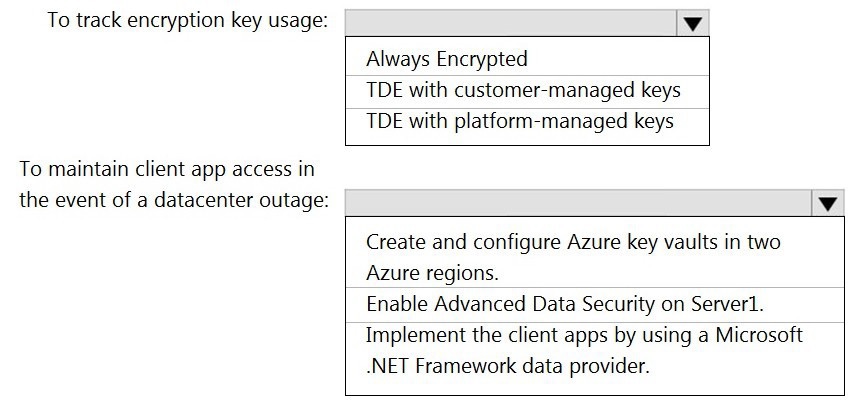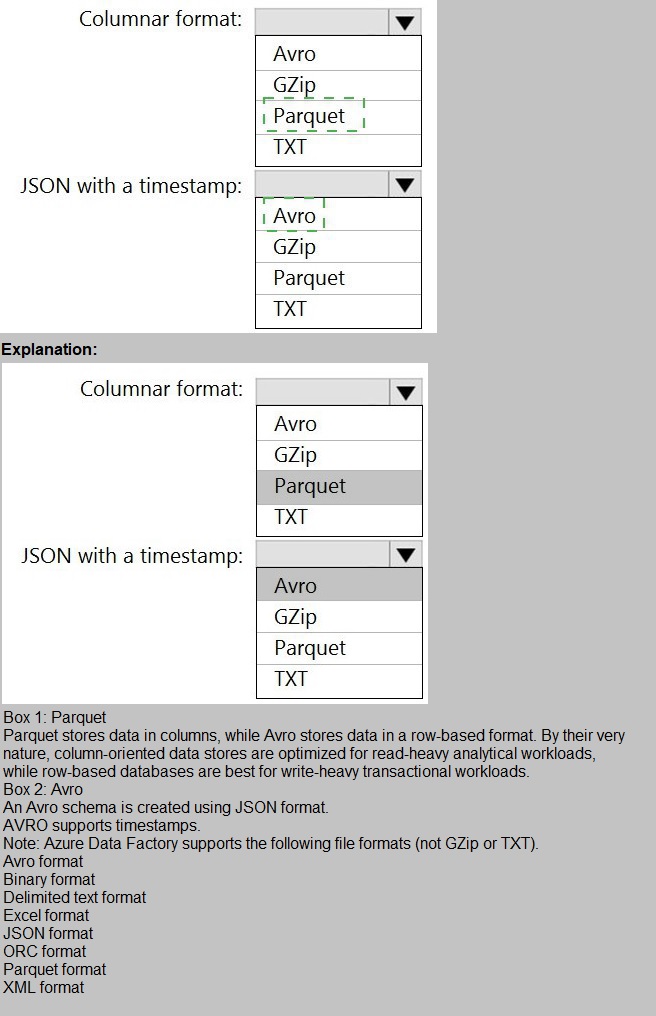Topic 3, Mix Questions
You use Azure Stream Analytics to receive Twitter data from Azure Event Hubs and to output the data to an Azure Blob storage account.
You need to output the count of tweets during the last five minutes every five minutes.
Each tweet must only
be counted once.
Which windowing function should you use?
A.
a five-minute Session window
B.
a five-minute Sliding window
C.
a five-minute Tumbling window
D.
a five-minute Hopping window that has one-minute hop
a five-minute Tumbling window
Explanation:
Tumbling window functions are used to segment a data stream into distinct time segments
and perform a function against them, such as the example below. The key differentiators of
a Tumbling window are that they repeat, do not overlap, and an event cannot belong to
more than one tumbling window.
References:
https://docs.microsoft.com/en-us/azure/stream-analytics/stream-analytics-window-functions
What should you recommend to prevent users outside the Litware on-premises network from accessing the analytical data store?
A
A.
a server-level virtual network rule
B.
a database-level virtual network rule
C.
a database-level firewall IP rule
D.
a server-level firewall IP rule
a server-level virtual network rule
Virtual network rules are one firewall security feature that controls whether the database
server for your single databases and elastic pool in Azure SQL Database or for your
databases in SQL Data Warehouse accepts communications that are sent from particular
subnets in virtual networks.
Server-level, not database-level: Each virtual network rule applies to your whole Azure SQL
You have an Azure subscription that contains a logical Microsoft SQL server named
Server1. Server1 hosts an Azure Synapse Analytics SQL dedicated pool named Pool1.
You need to recommend a Transparent Data Encryption (TDE) solution for Server1. The
solution must meet the following requirements:
Track the usage of encryption keys.
Maintain the access of client apps to Pool1 in the event of an Azure datacenter
outage that affects the availability of the encryption keys.
What should you include in the recommendation? To answer, select the appropriate
options in the answer area.
NOTE: Each correct selection is worth one point.

You have an Azure Storage account and a data warehouse in Azure Synapse Analytics in
the UK South region.
You need to copy blob data from the storage account to the data warehouse by using
Azure Data Factory. The solution must meet the following requirements:
Ensure that the data remains in the UK South region at all times.
Minimize administrative effort.
Which type of integration runtime should you use?
A.
Azure integration runtime
B.
Azure-SSIS integration runtime
C.
Self-hosted integration runtime
Azure integration runtime
You need to output files from Azure Data Factory.
Which file format should you use for each type of output? To answer, select the appropriate
options in the answer area.
NOTE: Each correct selection is worth one point.

You are designing an enterprise data warehouse in Azure Synapse Analytics that will
contain a table named Customers. Customers will contain credit card information.
You need to recommend a solution to provide salespeople with the ability to view all the
entries in Customers.
The solution must prevent all the salespeople from viewing or inferring the credit card
information.
What should you include in the recommendation?
A.
data masking
B.
Always Encrypted
C.
column-level security
D.
row-level security
data masking
Explanation:
SQL Database dynamic data masking limits sensitive data exposure by masking it to nonprivileged
users.
The Credit card masking method exposes the last four digits of the designated fields and
adds a constant string as a prefix in the form of a credit card.
Example: XXXX-XXXX-XXXX-1234
Reference:
https://docs.microsoft.com/en-us/azure/sql-database/sql-database-dynamic-data-maskingget-
started
You need to design an Azure Synapse Analytics dedicated SQL pool that meets the following requirements:
Can return an employee record from a given point in time.
Maintains the latest employee information.
Minimizes query complexity.
How should you model the employee data?
A.
as a temporal table
B.
as a SQL graph table
C.
as a degenerate dimension table
D.
as a Type 2 slowly changing dimension (SCD) table
as a Type 2 slowly changing dimension (SCD) table
Explanation:
A Type 2 SCD supports versioning of dimension members. Often the source system
doesn't store versions, so the data warehouse load process detects and manages changes
in a dimension table. In this case, the dimension table must use a surrogate key to provide
a unique reference to a version of the dimension member. It also includes columns that
define the date range validity of the version (for example, StartDate and EndDate) and
possibly a flag column (for example, IsCurrent) to easily filter by current dimension
members.
Reference:
https://docs.microsoft.com/en-us/learn/modules/populate-slowly-changing-dimensionsazure-
synapse-analytics-pipelines/3-choose-between-dimension-types
You have an Azure Synapse Analytics serverless SQL pool named Pool1 and an Azure
Data Lake Storage Gen2 account named storage1. The AllowedBlobpublicAccess porperty
is disabled for storage1.
You need to create an external data source that can be used by Azure Active Directory
(Azure AD) users to access storage1 from Pool1.
What should you create first?
A.
an external resource pool
B.
a remote service binding
C.
database scoped credentials
D.
an external library
database scoped credentials
Note: This question is part of a series of questions that present the same scenario.
Each question in the series contains a unique solution that might meet the stated
goals. Some question sets might have more than one correct solution, while others
might not have a correct solution.
After you answer a question in this section, you will NOT be able to return to it. As a
result, these questions will not appear in the review screen.
You plan to create an Azure Databricks workspace that has a tiered structure. The
workspace will contain the following three workloads:
A workload for data engineers who will use Python and SQL.
A workload for jobs that will run notebooks that use Python, Scala, and SOL.
A workload that data scientists will use to perform ad hoc analysis in Scala and R.
The enterprise architecture team at your company identifies the following standards for
Databricks environments:
The data engineers must share a cluster.
The job cluster will be managed by using a request process whereby data
scientists and data engineers provide packaged notebooks for deployment to the
cluster.
All the data scientists must be assigned their own cluster that terminates
automatically after 120 minutes of inactivity. Currently, there are three data
scientists.
You need to create the Databricks clusters for the workloads.
Solution: You create a High Concurrency cluster for each data scientist, a High
Concurrency cluster for the data engineers, and a Standard cluster for the jobs.
Does this meet the goal?
A.
Yes
B.
No
No
Explanation:
Need a High Concurrency cluster for the jobs.
Standard clusters are recommended for a single user. Standard can run workloads
developed in any language:
Python, R, Scala, and SQL.
A high concurrency cluster is a managed cloud resource. The key benefits of high
concurrency clusters are that
they provide Apache Spark-native fine-grained sharing for maximum resource utilization
and minimum query
latencies.
Reference:
https://docs.azuredatabricks.net/clusters/configure.html
You plan to implement an Azure Data Lake Storage Gen2 container that will contain CSV
files. The size of the files will vary based on the number of events that occur per hour.
File sizes range from 4.KB to 5 GB.
You need to ensure that the files stored in the container are optimized for batch processing.
What should you do?
A.
Compress the files.
B.
Merge the files.
C.
Convert the files to JSON
D.
Convert the files to Avro.
Convert the files to Avro.
Note: This question is part of a series of questions that present the same scenario. Each question in the series contains a unique solution that might meet the stated goals. Some
question sets might have more than one correct solution, while others might not have a
correct solution.
After you answer a question in this scenario, you will NOT be able to return to it. As a
result, these questions will not appear in the review screen.
You have an Azure Storage account that contains 100 GB of files. The files contain text
and numerical values. 75% of the rows contain description data that has an average length
of 1.1 MB.
You plan to copy the data from the storage account to an Azure SQL data warehouse.
You need to prepare the files to ensure that the data copies quickly.
Solution: You modify the files to ensure that each row is more than 1 MB.
Does this meet the goal?
A.
Yes
B.
No
No
Explanation:
Instead modify the files to ensure that each row is less than 1 MB.
References:
https://docs.microsoft.com/en-us/azure/sql-data-warehouse/guidance-for-loading-data
You plan to implement an Azure Data Lake Gen2 storage account.
You need to ensure that the data lake will remain available if a data center fails in the primary Azure region.
The solution must minimize costs.
Which type of replication should you use for the storage account?
A.
geo-redundant storage (GRS)
B.
zone-redundant storage (ZRS)
C.
locally-redundant storage (LRS)
D.
geo-zone-redundant storage (GZRS)
geo-redundant storage (GRS)
Explanation:
Geo-redundant storage (GRS) copies your data synchronously three times within a single
physical location in the primary region using LRS. It then copies your data asynchronously
to a single physical location in the secondary region.
Reference:
https://docs.microsoft.com/en-us/azure/storage/common/storage-redundancy
| Page 3 out of 18 Pages |
| Previous |